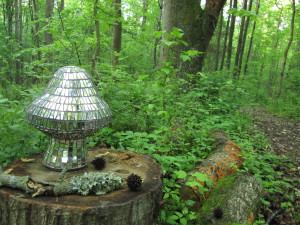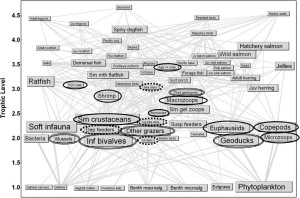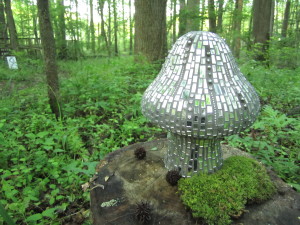
“DNA” can be found along the Java Trail.
by Heather Soulen
This year’s theme for SERC’s annual Open House is “Ecosystem Conservation: Where do you fit in?” In the broadest sense, this question got me thinking about people, ecosystem research and conservation. How do we conserve ecosystems and make realistic and manageable policies? As a scientist, science writer/communicator and artist, I decided to explore these question through art, specifically mosaics.
Using art as a way to raise awareness, express one’s thoughts or as a way to create dialog is one of the most wonderful and powerful things about art. Humans have been creating art for some 40,000 to 60,000 years and this timeline could extend farther back as new techniques and technologies become available and new cave art discoveries are made. Over the past decade some field stations and laboratories have incorporated arts and humanities into their programs. Many see it as an opportunity to communicate an agency’s mission, the scientific process, science discoveries and complex scientific concepts or areas of study. A recent essay in the Ecological Society of America’s Ecosphere explores the convergence of science, art and humanities and why it could be important to sustainability, ecosystem stewardship, ecosystem services and conservation strategies in the future.
For the last 50 years, the prevailing view of conservation has changed several times, shifting the emphasis from species to ecosystems. The most recent shift has been from “nature for people,” where ecosystems, ecosystem services and the economic value of an ecosystem are the focus, to “nature and people,” where we think about environmental change, resilience and adaptability, and socio-ecological systems. Both views are ecosystem-based and present complex challenges to scientists, policymakers and managers. People and nature are inherently complex and assigning a value to various aspects of nature is quite difficult. What is the value of human well-being? How do we measure our multilayered and multidimensional relationship with nature? What kind of data should be collected? How do you analyze that data when science, societies and cultures value nature differently? Adaptability and resilience of species, ecological communities and ecosystems are often the result of biological and physical processes that need the right pieces in place at scales (i.e., size of space and time) that human management can’t easily allow for. Some ecosystems could take centuries to recover properly, well beyond the typical timescale for environmental policies. These are only a few points conservationist grapple with when considering ecosystem management.
Reflections of Ecosystems
To explore ecosystem conservation and the concept of people as part of ecosystems and nature, I created five mirror mosaic mushrooms. The material, placement and pattern of each mosaic piece highlights concepts related to science and conservation. My hope is that you’ll gaze closely at these science art works and think about “nature and people.” Everything reflected in the mirror pieces is part of an ecosystem, including you. Download this science art location map: SciArt SERC trail Map.
Spores: Reed Education Center

“Spores” can be found at the Reed Education Center.
The large glass domes on this piece represent spores, a form of asexual reproduction in bacteria, fungi and green plants. Each glass dome is wrapped with bars of mirror, indicating wind movement and dispersal. Fungal spores can travel great distances from the original fruiting body (e.g., mushrooms). Often they are carried on localized or self-created wind currents and even high altitude jet streams.
Hyphae: Administration and Mathias Garden
Hyphae are tubular structures fungi use to take in nutrients and are the main method for vegetative growth. In this piece, rhinestones represent hyphae. Hyphae develop into fruiting bodies (e.g., mushrooms) that produce spores. Once a spore lands and conditions are suitable, the spore sends out hyphae to establish the fungus and gather nutrients.
DNA: Java Trail
This piece is covered with mirror cut into pieces resembling the teeth of a zipper. When scientists perform PCR as part of DNA studies used in conservation, an enzyme called helicase is used to unzip specific targeted sections of DNA.
Food Webs: Connection Trail (marsh boardwalk)

Food web model. Photo by NOAA.
Food web models often look like lots of triangles when linking prey to predators. This piece has triangle mirror pieces in the shape of a wave, indicating flow and movement of energy though an ecosystem. The wave also touches on how food web models can change over time based on the presence and absence of organisms and environmental conditions within that ecosystem.
Scale: Discovery and Connection Trial Crossroads

“Scale” can be found at the intersection of the Discovery and Connection Trails.
This piece is meant to draw attention to scale. Time and spatial scales are often incorporated into research studies. Mirrors of differing sizes and shapes are meant to illustrate the importance of scale in ecosystem ecology and conservation. Scale is also important when we talk about conservation efforts and how an effort at one scale (time or space) may be successful, but at another scale may not be successful.
We hope that you’ll visit our campus and see our outdoor science art exhibit. This exhibit will run for three months. Our campus and trails are open Monday through Saturday from 9a.m. to 4:30p.m., with the exception of federal holidays. If you visit our exhibit, please let us know what you think of it in our comments section.

